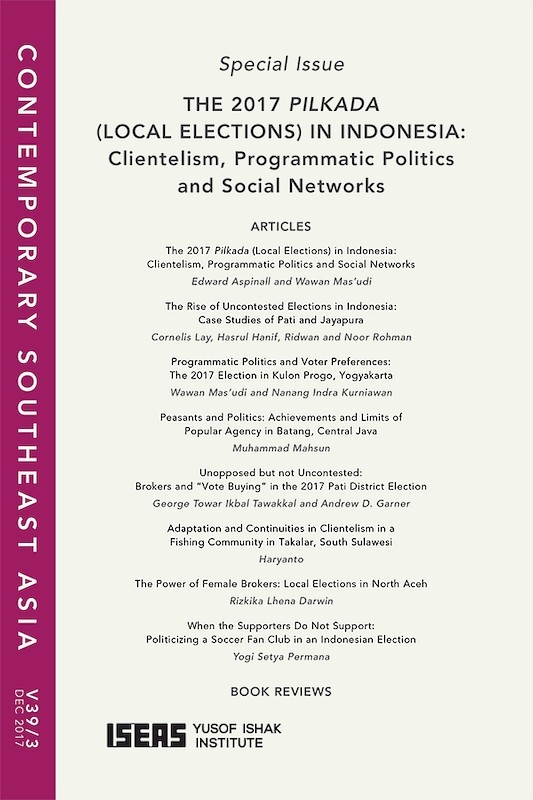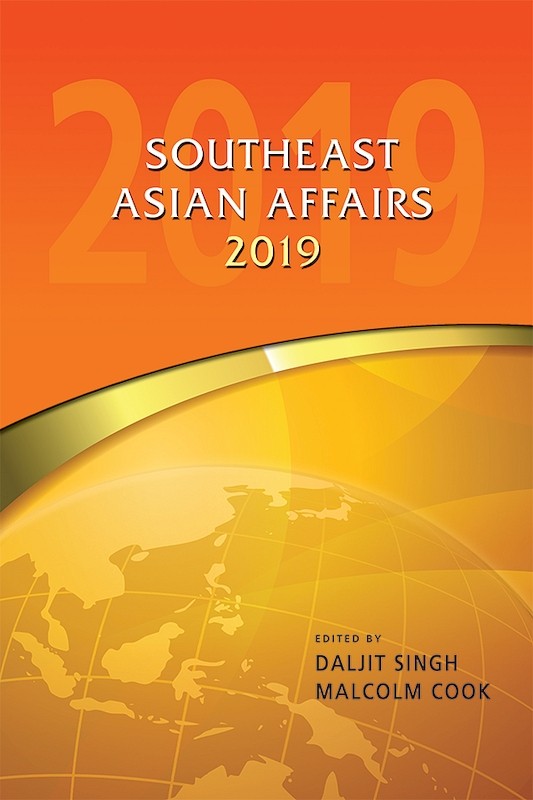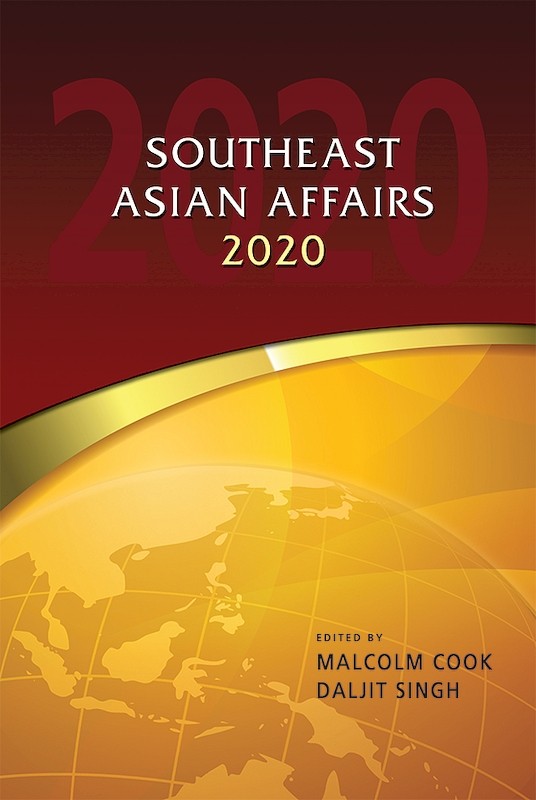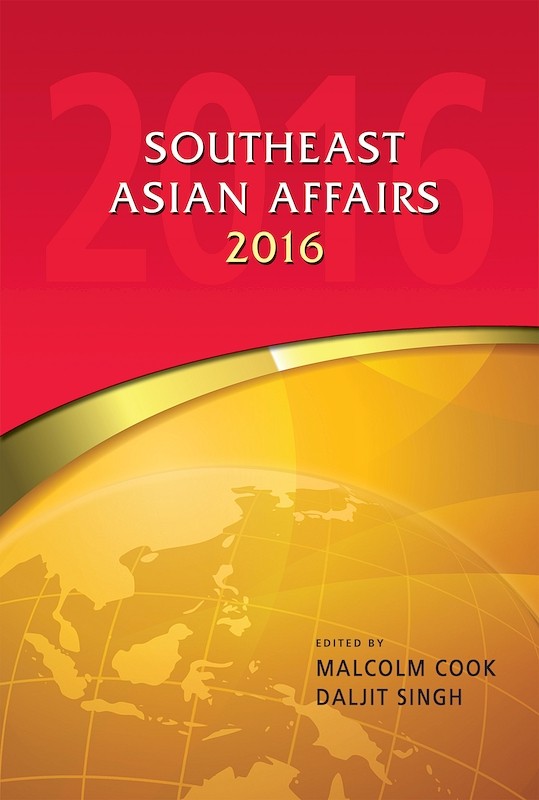Southeast Asian Affairs 2018
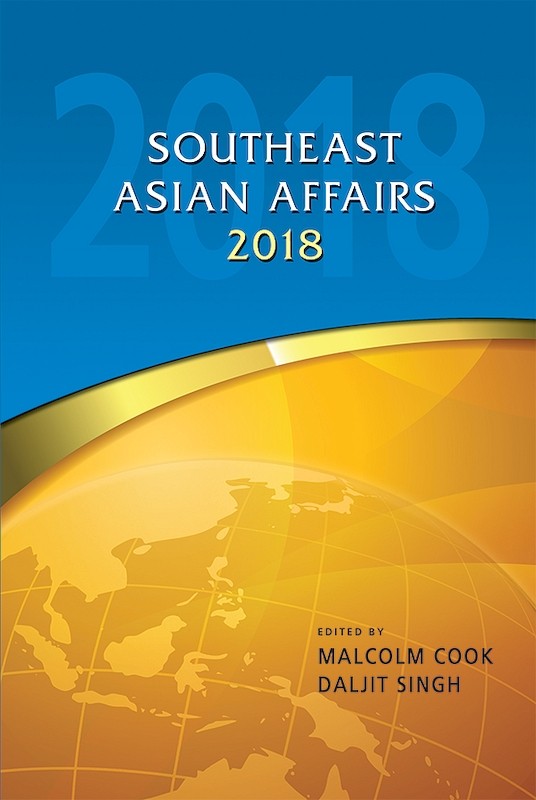
Date of publication:
2018
Publisher:
ISEAS – Yusof Ishak Institute
Number of pages:
444
Code:
SEAA18
Hard Cover
ISBN: 9789814786836
About the publication
“Southeast Asian Affairs, first published in 1974, continues today to be required reading for not only scholars but the general public interested in in-depth analysis of critical cultural, economic and political issues in Southeast Asia. In this annual review of the region, renowned academics provide comprehensive and stimulating commentary that furthers understanding of not only the region’s dynamism but also of its tensions and conflicts. It is a must read.”
– Suchit Bunbongkarn, Emeritus Professor, Chulalongkorn University
“Now in its forty-fifth edition, Southeast Asian Affairs offers an indispensable guide to this fascinating region. Lively, analytical, authoritative, and accessible, there is nothing comparable in quality or range to this series. It is a must read for academics, government officials, the business community, the media, and anybody with an interest in contemporary Southeast Asia. Drawing on its unparalleled network of researchers and commentators, ISEAS is to be congratulated for producing this major contribution to our understanding of this diverse and fast-changing region, to a consistently high standard and in a timely manner.”
– Hal Hill, H.W. Arndt Professor of Southeast Asian Economies, Australian National University
Contents
-
Southeast Asian Affairs 2018
[Whole Publication, ISBN: 9789814786843], by Malcolm Cook, Daljit Singh, editors -
Preliminary pages
- THE REGION
-
Notes on the Future of Southeast Asian Studies, by Nicholas Farrelly, author see abstractWhat we now recognize as Southeast Asian Studies emerged after the Second World War, just as a new region emerged from the colonial shadows. During the second half of the twentieth century, a new Southeast Asian core coalesced, initially, around a group of societies with relatively consistent pro-Western policies — Indonesia, Singapore, Malaysia, Thailand and the Philippines — ruled by various styles of nationalist strongmen. Since then, Southeast Asia has been upended by the increasing wealth, connectivity and interaction within societies, and across the region. Notions, inherited from the twentieth century, that Southeast Asia is weak and requires charity no longer match local realities or ambitions. Higher levels of literacy, and greater attention to the economic benefits available to increasingly sophisticated publics, mean that the audience for analysis about Southeast Asia also continues to grow. Any ongoing contest of ideas about this region, especially in those places where authoritarian systems of government hold sway, can only be a good thing.
-
Southeast Asia on the Economic Front: Holding Steady, Bracing for Change, by Hwok-Aun Lee, author see abstractSoutheast Asia experienced a relatively stable and uneventful 2017, but long-term challenges came to the fore. The drama of economic and political affairs paled in comparison to the preceding two years, when commodity and currency price fluctuations, and Brexit and Trump’s election, raised anxieties leading into the new year, but these were somewhat allayed as growth reinvigorated and macroeconomic conditions generally held steady. The region’s economies registered robust economic growth in 2017, sustained by vibrant exports and investment, including foreign direct investment inflows. These conditions bode well for the coming years, while trade deficits and government debt warrant careful consideration and prudent management. Important challenges also confront Southeast Asia in these times, saliently, in managing structural change and maintaining vibrant manufacturing sectors, generating employment growth and safeguarding social protection, and expanding and modernizing infrastructure. While the near outlook is positive, the region must industriously lay foundations for sustained economic and social progress.
-
Year One of the Trump Administration's Policy: Uncertainty and Continuity, by Walter Lohman, author see abstractDonald Trump’s election as President of the United States raised major concerns about America’s commitment to its traditional interests in the Asia Pacific. As his first year in office unfolded, however, his Asia policy came to have more in common with those of his predecessors than differences, with one exception — international trade. Relationships with allies, particularly, in Northeast Asia were shored up throughout the year, aided by the near-term threat of North Korea’s nuclear weapons programme. The relationship with China also found firmer footing, even as the administration maintained its legal commitments to Taiwan. On the diplomatic side, U.S. engagement was symbolized by a busy schedule of leader visits to the United States and a long presidential tour of the region in November. Any scepticism the president may have had about multilateralism apparently did not extend to the annual APEC and ASEAN meetings to which he committed to early and which served as the anchors for his trip. Contrary to expectations, the Trump administration was also engaged on values issues. The break with the past came in the area of trade. By the end of the year, there were no signs that the protection-oriented approach that dominated his campaign rhetoric had evolved.
-
Southeast Asia in 2017: Grappling with Uncertainty, by Joseph Chinyong Liow, author see abstractThe year 2017 was an important one for Southeast Asia. Under the chairmanship of the Philippines, ASEAN celebrated the great strides it made in regional diplomacy since its formation fifty years ago. Yet it was also a difficult and challenging year. Perennially having to navigate great power politics, Southeast Asian states found themselves at the intersection of shifts of distribution of power and influence yet again, not least when the United States entered an era of uncertainty with the election of Donald Trump, and China consolidated power under Xi Jinping at the 19th Party Congress. Challenges also emerged from within the region in the form of an acute humanitarian crisis in Rakhine State, Myanmar, and the siege of Marawi City by Southeast Asian terrorists aligned with the Islamic State, all of which contrived to threaten regional stability, strain ASEAN unity, and test the Philippine chairmanship.
- BRUNEI DARUSSALAM
-
Brunei Darussalam: The “Feel-Good Year” Despite Economic Woes, by Pushpa Thambipillai, author see abstractThe golden anniversary of the ascension to the throne of Sultan Hassanal Bolkiah provided a continual focal point for the government and peoples of Brunei Darussalam in 2017. Despite the lingering economic recession since 2014 following the drastic drop in oil prices, the country managed to ride the storm by streamlining its expenditures, but not when it came to celebrating the fiftieth anniversary of the Bolkiah reign. In the absence of any major political or social disruptions, the year portrayed an overwhelming unity in upholding the Malay Islamic Monarchy (MIB) ideology.
- CAMBODIA
-
Cambodia 2017: Plus ça change…, by Khatharya Um, author see abstractWhile the months leading to the June commune elections in Cambodia brought the customary machinations and jitters, it was the post-election developments that dashed whatever hope for political change may have been engendered by the results of the last two elections. While election-related violence is not unprecedented, the crackdown against regime opponents in the months following the June elections were wholesale and decisive, with consequences that potentially extend beyond the 2018 elections. Though international condemnation was forthcoming, geopolitics and states’ expedient interests underscore the limits of sanctions. Besides its political significance, China’s expanding influence in Asia also has profound economic, social and environmental ramifications. Chinese financed hydrodam projects and economic land concessions have engendered mass dislocations, while deforestation has deprived many forest-dependent communities of their livelihoods. These developments combined call into question the survivability of political pluralism in Cambodia, and further dim the prospect of a more inclusive and equitable future for the country’s population.
-
Cambodia–Vietnam: Special Relationship against Hostile and Unfriendly Forces, by Steve Heder, author see abstractRelying heavily on official Vietnamese- and Khmer-language sources, this chapter examines Cambodia–Vietnam relations in the light of the recent dramatic turn in Cambodian domestic politics, in which the Cambodia National Rescue Party (CNRP), the main political opposition, was dissolved, and its top 118 figures banned from politics for five years, while Its leader, Kem Sokha, was detained for prosecution for alleged treason. The article argues that these moves reflect a special relationship between the Cambodian People’s Party (CPP) and the Communist Party of Vietnam (CPV), a main pillar of which is ties between their security forces, and their common interest in ending what they see as the political threat of the CNRP, which they jointly define as a “hostile” or “unfriendly force” because of its challenges to CPP dominance and current Cambodia–Vietnam border arrangements and its perceived potential for allowing Cambodia to become a base for anti-CPV activities.
- INDONESIA
-
Inequality, Nationalism and Electoral Politics in Indonesia, by Eve Warburton, author see abstractWith presidential elections on the horizon, the political opponents of President Joko Widodo (Jokowi) have stepped up their attacks on his economic record. Their emerging campaign focuses partly upon missed targets and poor policy execution. Primarily, however, Jokowi’s rivals have begun to craft a nationalist and populist critique that stirs public anxiety about foreign, and particularly Chinese, investment, and claims the economy has offered disproportionate benefits to the non-Muslim minority. Jokowi faced a similar campaign back in 2014, and won. So how vulnerable is he today to this populist-nationalist narrative? What aspects of the president’s economic agenda over the past three years might expose him to this kind of campaign? And what does the rise of anti-foreign and anti-Chinese discourse reveal about the nature of electoral politics in post-Suharto Indonesia?
-
Indonesia in 2017: Jokowi’s Supremacy and His Next Political Battles, by Priyambudi Sulistiyanto, author see abstractThis chapter highlights key trends in Indonesia in 2017 in the areas of domestic politics, the economy and foreign policy. It discusses the ways in which Jokowi navigated the complex Indonesian political landscape and stayed on top of the game, considers the consequences for Jokowi’s looming political battles in the 2019 presidential election of the arrest of Setya Novanto, the Chairman of the House of Representatives and the appointment of Marshall Hadi Tjahjanto as the new Armed Forces Chief, and examines briefly the implications of local elections for governors across Indonesia in 2018. It suggests that towards the end of 2017, Jokowi has gone beyond consolidation of power and has strengthened his presidency even further.
- LAOS
-
On the Right Track? The Lao People’s Democratic Republic in 2017, by Oliver Tappe, author see abstractThe year 2017 was an important one to assess the performance of the new government of Laos. Prime Minister Thongloun Sisoulith tackled key problems of Lao governance and economy — most notably corruption and illegal logging — earning him both domestic and international esteem. However, Laos still faces numerous socioeconomic challenges such as weak legal institutions, poverty, environmental degradation, and a civil society subdued. According to the 8th Five-Year National Socio-Economic Development Plan (2016–21), Lao economic policies focus on elevation from the LDC ranks through mega projects like hydropower dams, mines and large-scale infrastructure projects — negative social and ecological side effects notwithstanding. China and many ASEAN countries compete in large-scale investment in these fields. The Lao–Chinese railway linking Kunming with Vientiane is a case in point. This chapter gives an overview of political and economic tendencies in the Lao PDR at the beginning of the new five-year cycle.
- MALAYSIA
-
Johor and Traditionalist Islam: What This Means for Malaysia, by Norshahril Saat, author see abstractBased on a survey conducted by the ISEAS – Yusof Ishak Institute in May–June 2017, one can conclude that Johor Malays are becoming more conservative, exclusivist and “Arabized”. Many scholars on Malaysia have made similar conclusions, not only about Johor Malays but about Malaysian Malays in general, recognizing that Salafism-Wahhabism has penetrated substantially into the country’s political and social life. What do these trends mean for Islam in Johor and Malaysia. The southern state of Johor has always been considered, and remains, the bastion of <i>kaum tua</i>, with its religious institutions dominated by <i>ulama</i> (religious scholars) who are traditionalist in character but tolerant of religious practices that are infused with local culture and mysticism. These scholars have also tended to maintain conservative attitudes on gender issues, inter-religious relations, and intra-faith differences. This chapter makes three conclusions: first, the fact that Johor is an urban state does not mean its society is religiously progressive; second, the progressive orientation of the Sultan does not translate into a progressive society; and third, conceptualizing Islam in Malaysia should move beyond Wahhabi-Salafi versus Sufi rhetoric.
-
Malaysia in 2017: Strong Economic Growth amidst Intense Power Struggle, by Faisal S Hazis, author see abstractThe year 2017 was a fractious and unsettling one for Malaysia. The ruling party was embroiled in an intense political struggle with the opposition that was destabilizing the country and threatening the party’s six decades of uninterrupted rule. However, as the year drew to a close, Prime Minister Najib Razak fortified his grip on federal power whilst the fragmented opposition failed to get its act together. Despite the intense political struggle, Malaysia’s economy grew at the fastest pace in more than three years. Nonetheless, some critics argued that there seemed to be a disconnect between the strong GDP and the reality on the ground. Another growing concern was Malaysia’s spiralling debt burden. On the diplomatic front, Malaysia continued to assert its role as a middle power through a series of diplomatic visits and initiatives. But sceptics contended that Malaysia had lost its way as a middle power due to weak leadership and endless scandals.
- MYANMAR
-
Stability and Expectations: Economic Reform and the NLD Government, by Aka Kyaw Min Maw, author see abstractEconomic performance under the first year of the NLD government stabilized at a moderate growth rate, following difficulties faced in the previous year. Despite a slower growth rate and lower foreign direct investment, the government was able to keep inflation lower, narrow the fiscal deficit, and reduce the current account deficit. Along with the stabilized economy, public opinion on economic performance was positive in 2017. Significant achievements were observed in the financial/banking and investment sectors due to enactment of the new investment law and the execution of the first-ever treasury bond auctions, which immediately impacted positively on fiscal deficit. Despite these developments, significant weaknesses of the government were observed due to the slow pace of policy priorities, policy clarity and seeming negligence on economic reforms. In short, in its first year in office, the government suffered in relation to the high expectations of the business community, even though it managed to stabilize the economy.
-
Myanmar in 2017: Crises of Ethnic Pluralism Set Transitions Back, by Mary Callahan, author see abstractThroughout 2017, Myanmar faced ongoing challenges to its democratic and economic transitions that were rooted in the high stakes ethnic politics. New attacks by the Arakan Rohingya Salvation Army along with long-simmering intercommunal tensions in Rakhine State escalated to large-scale violence and an unprecedented refugee exodus of more than 625,000. The government-led peace process continued to deteriorate, with no obvious progress in the formal negotiations and a realignment of armed organizations that gives formerly excluded groups along the northern border with China ultimate sway over whether any progress will unfold. Entering her second year in office, State Counsellor, National League for Democracy (NLD) leader and Nobel Peace Prize laureate Aung San Suu Kyi faced widespread international criticism for how she and the Defence Services managed the evolving Rakhine State crisis, while domestic popular support grew around the Rohingya issue and regional allies — especially China — rallied behind the military and the State Counsellor.
- PHILIPPINES
-
The Philippines in 2017: Turbulent Consolidation, by Malcolm Cook, author see abstractThe year was one of political consolidation in the Philippines in which President Duterte's personalistic and confrontational approach to the presidency held sway. Despite some very significant setbacks in the war on drugs and the peace processes with the communists and in Muslim Mindanao, President Duterte remained very popular across all adult demographics. The Philippine economy continued to be very strong and the first, most important phase of tax reformm was completed. At the end of 2017, relations with the United States, China and Japan were also stronger than at the beginning of the year.
-
Narratives and Counter-narratives: Responding to Political Violence in the Philippines, by Dennis Quilala, author see abstractThis chapter argues that political violence, particularly terrorism and internal armed conflicts in Mindanao, have not been properly addressed in the Philippines. Terrorism in the Philippines and Southeast Asia is not something new. The Philippine government has passed laws and improved law enforcement capabilities to address the menace of terrorism. It has engaged the international community, realizing the transnational nature of terrorism. These efforts, however, are not enough, and therefore similar responses today contribute to the narrative that the use of violence against violent non-state armed groups would suffice. It is further argued that a strategy towards the prevention of extremism needs to be crafted and the involvement of the community would be necessary to address terrorism in the Philippines. The peace strategy with the different armed groups should also be more inclusive. Narratives have to be adjusted and counter-narratives have to be asserted.
- SINGAPORE
-
Singapore in 2017: Testing Times, Within and Without, by Shashi Jayakumar, author see abstractBy almost any traditional measure — including the maintenance of security and economic progress, Singapore did reasonably well in 2017. However, the reality was that its resilience was tested by a variety of issues — an unexpected and very public spat within the family of Prime Minister Lee Hsien Loong, continuing problems in transport infrastructure, the persistent threat of a terror attack (which the government has said will occur at some point), as well as more insidious threats such as cyber hacks and coordinated forms of subversion. The leadership has shown that it has a handle on these issues, but the look and shape of the leadership apex itself in the era after Lee Hsien Loong (who has made succession an urgent issue to be prioritized) continues to invite debate, discussion and questions. The next generation of leaders has indicated that there is no reason for the people to be concerned. Should they be?
-
Singapore–China Relations: Building Substantive Ties amidst Challenges, by Lye Liang Fook, author see abstractSingapore and China today enjoy a multi-faceted and substantive relationship. Under China’s Belt and Road Initiative, they are collaborating in new areas like finance, legal and judicial matters and the Chongqing Connectivity Initiative. The latter initiative bucks the general trend of countries being recipients of China’s investments to one where Singapore is investing in China. Simultaneously, the bilateral relationship is shaped by broader factors such as the relative power between China and the United States, and China’s rise and its expectations of how other countries ought to respond to its rise. Singapore will likely continue to emphasize the rule of law in its foreign policy while China, as a major power, is expected to accord more credence to the exercise of its power. While this difference could affect relations from time to time, it is not a difference that is strategic in nature.
- THAILAND
-
Thailand in 2017: Stability without Certainties, by Pongphisoot Busbarat, author see abstractThis chapter provides an overview of recent development in Thailand’s politics, socio-economic and foreign policy. It asserts that while Thailand may have experienced stability in 2017, it did not necessarily correspond with the positive potentials. Thailand still faces uncertainties in all aspects. The military will play a major role in Thai politics and will attempt to shape its direction. However, it is uncertain how acceptable the new politics and power sharing will be to all parties. Conflicts among political forces, including the establishment, political parties and the masses, will be likely to develop in the future. Moreover, Thailand has experienced slow economic growth and socio-economic disparity that prevents it from overcoming the middle-income gap problem. The government has introduced a new economic model, Thailand 4.0, that will solve this problem by upgrading the economy into the innovative sector. However, there are doubts among foreign investors on its prospect. Therefore, Thai policymakers are expecting that Thailand can benefit from China’s Belt and Road Initiative. However, the tendency to depend on China for economic objectives will put Thailand’s foreign policy in a difficult situation where Beijing will be able to influence and put more pressure on Thai policymaking. The normalization of Thai–U.S. relations may help Bangkok readjust its balanced position in the future. Nevertheless, it is uncertain that Bangkok can do so effectively considering America’s reduced engagement in East Asia’s economic dynamics and Thailand’s insignificant place in U.S. foreign policy in Asia.
-
Haunted Past, Uncertain Future: The Fragile Transition to Military-Guided Semi-Authoritarianism in Thailand, by Prajak Kongkirati, author see abstractThe National Council for Peace and Order (NCPO) led by General Prayuth Chan-ocha came to power on 22 May 2014 after it toppled the elected government of Yingluck Shinawatra. Through constitutional design, the Prayuth administration has devised a strategic plan to move Thailand towards semi-authoritarianism guided by the military. There is a strong possibility that the NCPO will support political parties to contest in the coming poll to ensure that the junta could control the country after the election. The NCPO has two models it could adopt: one is to set up a military party led by top brass, and the second is to back a nominee party headed by civilians. Considering the failure of “military parties” in past elections, however, one cannot expect to see a smooth return to democracy in the next election. An unruly election, the resurgence of street protests, and a short-lived coalition government are more plausible outcomes for Thailand in 2018.
-
Thailand's Southern Insurgency in 2017: Running in Place, by Matt Wheeler, author see abstractIn 2017 the long-running insurgency in southernmost Thailand saw the lowest level of casualties since 2004, but it was still characterized by a grim routine of violence and unrealized promises of progress in the peace-dialogue process between the government and MARA Patani, an umbrella group of Malay-Muslim separatist groups. The dialogue teams met regularly, despite provocative insurgent attacks, but without achieving any agreement or evident progress. The year ended as it began, with optimistic pronouncements from Thai officials about prospects for establishing safety zones, selected districts where the belligerents would refrain from attacks and jointly investigate any violent incidents. A brief unilateral ceasefire in April by the main militant group, Barisan Revolsui Nasional Melayu Patani (Patani-Malay National Revolutionary Front, BRN), and its concurrent statement that it is willing to talk with Bangkok under certain conditions, indicated that although BRN shuns the existing dialogue process, it cannot ignore it. The conflict remains mired in stalemate, the belligerents more content with the dismal status quo than the risks of compromise or attempts to employ decisive force.
- TIMOR-LESTE
-
Timor-Leste in 2017: A State of Uncertainty, by Rebecca Strating, author see abstractTimor-Leste enters 2018 facing an uncertain future on a number of political and economic fronts. This review focuses on three issues: first, the progress of resolution of the Timor Sea dispute with Australia in 2017; second, Timor-Leste’s bid for ASEAN membership; and finally, the processes and outcomes of the presidential and parliamentary elections. By the year's end, the events of 2017 relating to these key issues have left Timor-Leste’s political situation in an indeterminate state.
- VIETNAM
-
Vietnam in 2017: Power Consolidation, Domestic Reforms, and Coping with New Geopolitical Challenges, by Nguyen Manh Hung, author see abstractThree distinct characteristics of Vietnam’s development in 2017 were the consolidation of power in the hands of the Communist Party of Vietnam and its leadership under General Secretary Nguyen Phu Trong leading to a series of high-profile trials and a big purge; politico-administrative reforms under the banner of an “enabling government” to streamline the political system and promote private businesses; and fashioning a foreign policy to deal with a worsening international environment resulting from the accession to power of President Rodrigo Duterte in the Philippines and President Donald Trump in the United States in the context of China’s rise and its emboldened attempt to impose China’s interpretation of international law in the South China Sea.
-
Force Modernization: Vietnam, by Carlyle A. Thayer, author see abstractThis chapter presents an historical overview of Vietnam’s efforts to modernize its armed forces from the mid-1990s to the present. Force modernization is conceptualized as two distinct yet interrelated processes: (1) reconditioning and upgrading existing stocks of weapons and platforms with new technology and (2) the acquisition of more modern sets of platforms and weapon systems to meet new roles and missions. This chapter examines in detail Vietnam’s efforts to modernize its navy, air defence air force, army and national defence industry. During the period 2012–16, Vietnam was the tenth largest importer of arms globally. The chapter concludes with a discussion of seven major challenges Vietnam will face in integrating its new systems and weapons and in creating a joint force.


